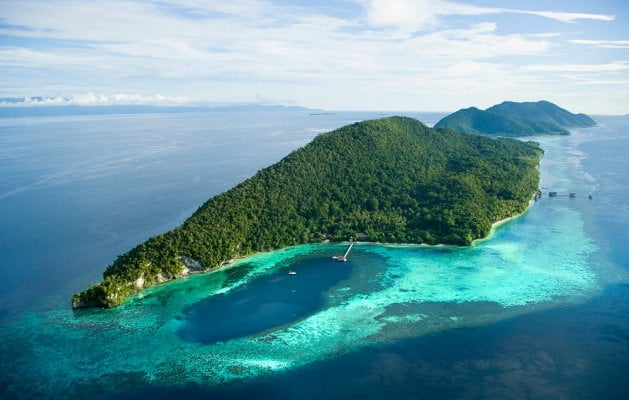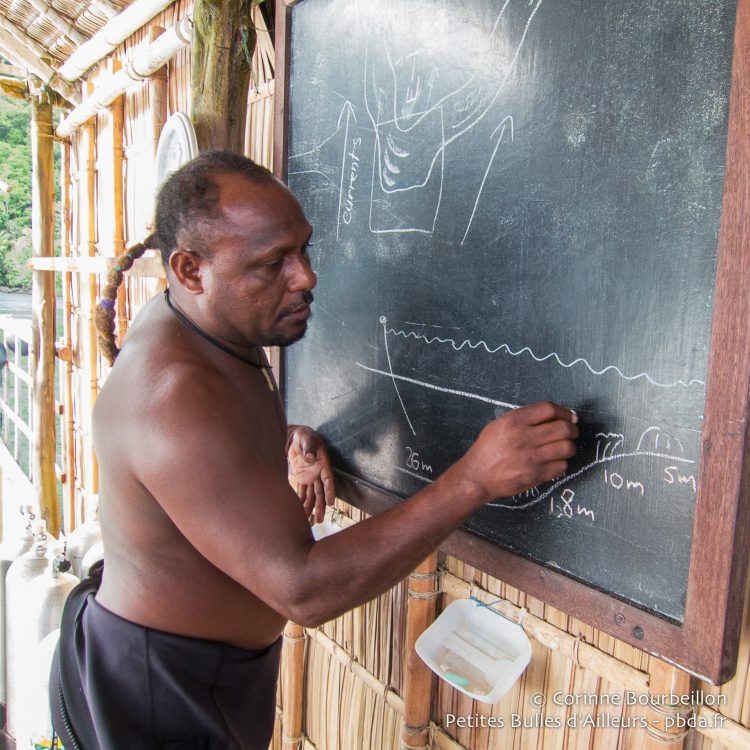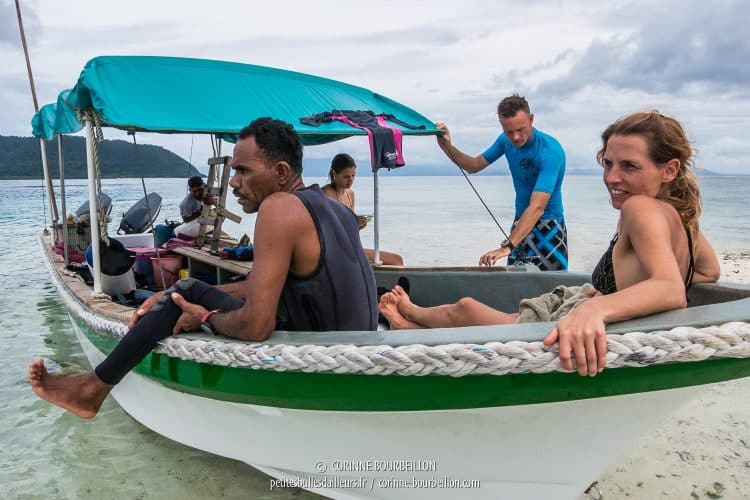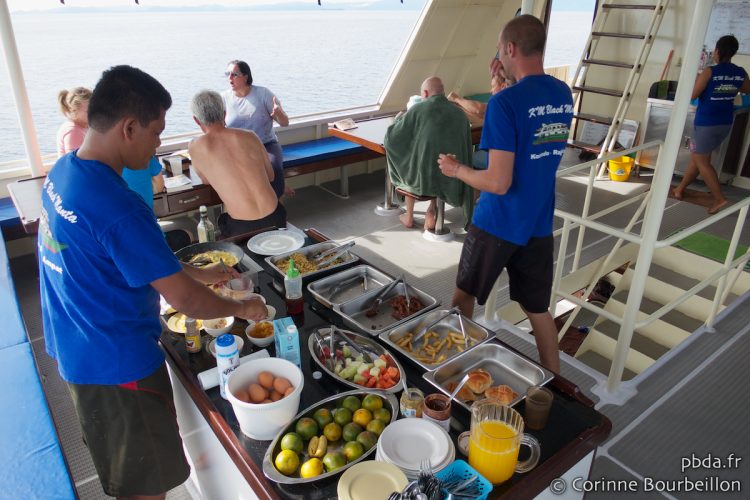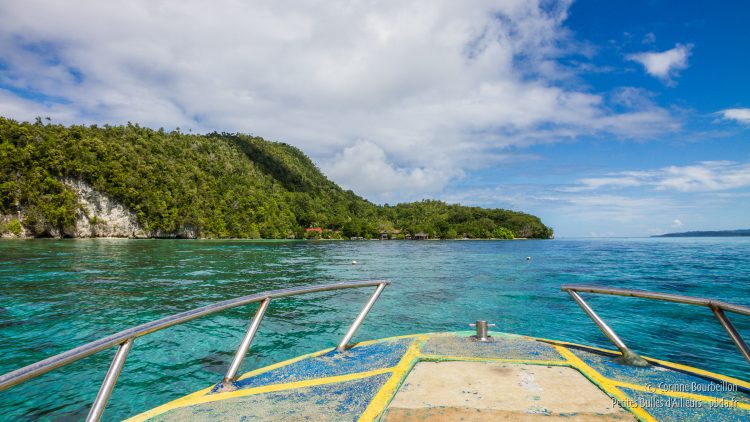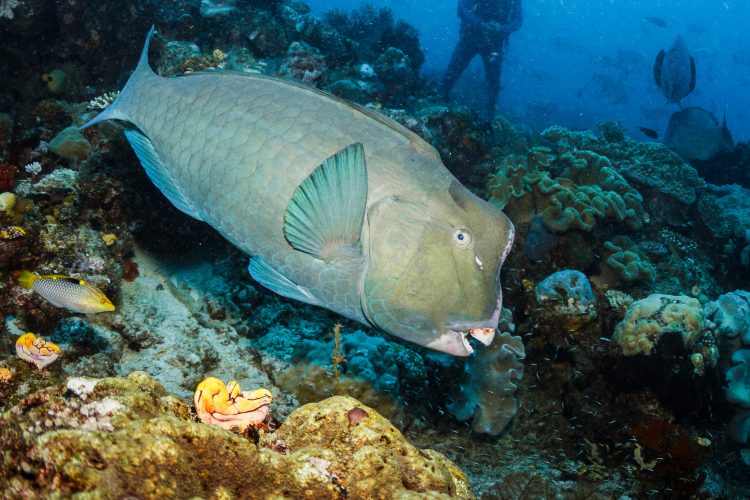Indonesia: Bangka [Sulawesi] + Rao [Halmahera] + Raja Ampat [Papouasie] - July 2019
Dear English-speaking readers, this page is an automatic translation of an article originally written in French. I apologise for any strange sentences and funny mistakes that may have resulted. If you read French, click on the French flag below to access the original, correct text:
Raja Ampat is where I've done some of the best diving of my life. But tourism, which is booming on these remote Indonesian islands, is endangering the seabed and the region's exceptional biodiversity.
You dream of going to Raja Ampat ? To dive in its turquoise waters, full of fish? Here's a 16-point summary of what you need to know before you leave, and lots of useful information to help you plan your trip and organize your stay...
Summary
- A natural paradise to be preserved
- Where is Raja Ampat?
- I'm not a travel agency
- All my diving trips to Raja Ampat
- When to go to Raja Ampat?
- How do I get to Raja Ampat?
- Don't forget the permit
- Diving resorts
- Diving cruises
- Hotels in Sorong
- The homestays
- Kayak and nature
- Getting around the archipelago
- Diving in Raja Ampat : the best sites
- A threatened nature
- Books about Raja Ampat
1. Raja Ampat, a natural paradise to be preserved
Raja Ampat means "the Four Kings". Located in the extreme east of Indonesia, it is a vast archipelago composed of four main islands (Waigeo, Batanta, Salawati, Misool) and a multitude of karst islands covered with jungle, plunging into the turquoise water. An extraordinary and splendid environment.
Admire below, in 360°, the view from the island of Piaynemo, emblematic of the region...
Above, the viewpoint Piaynemo on the islets of Fam, emblematic of Raja Ampat's landscapes... We see Otto, my great Papuan dive guide, and my partner Sarah.
Raja Ampat is an exceptional archipelago, for its beauty and its biodiversity, on land and under water. This magnificent end of the world, long isolated, is in the middle of the famous Coral Trianglebetween the Indian and Pacific oceans. In France, the general public discovered these wild islands on TV, with the programmes Ushuaïa in 2008 and Koh-Lanta in 2011... .
But tourism development in the region accelerated in the decade before Covid. And again afterwards, with the return of visitors. With disastrous consequences for the environment... Presented as a "dream destination" or "the last paradise" to us privileged tourists, the Raja Ampat archipelago is above all a natural treasure that must be preserved and protected. But we must be aware that each of our visits and dives has an impact on this unique and fragile ecosystem, as well as on the Papuan communities who live there...
I invite you to support the Franco-Indonesian association The SEA People - Orang Laut (The People of the Sea)which aims to encourage sustainable ecotourism for all (locals, visitors, tourism operators, government authorities) since the reopening of post-Covid borders, after the visitor boom in 2019. I wrote about it in this article for Ouest-Franceon the eve of World Ocean Day on June 8, 2022:
➜ Raja Ampat, these paradise islands that want to turn tourists into coral protectors

Read also: this worrying state of affairs in 2020 by The SEA People - Orang Laut association. It details the damage caused to coral reefs in particular by overly rapid and unsustainable tourism development in Raja Ampat :
➜ Raja Ampat: Reefs under threat
"Thanks to Covid, the flow of tourists dried up from March 2020 for almost two years. The 20 Hours of France 2 broadcasted, on Wednesday January 12, 2022, a report on Raja Ampat, visible in replay here : Raja Ampat, an Indonesian archipelago in a coral paradise. We follow Arno Brival of the association The SEA Peopleand Dolvinus Awom, one of the dive guides of Papua Diving. I put you the video player below :
A similar report, presenting the Yaf Keru coral restoration project run by The SEA People team, was broadcast the following year by TF1. It featured the association's Arno Brival and Max Ammer of Papua Diving:
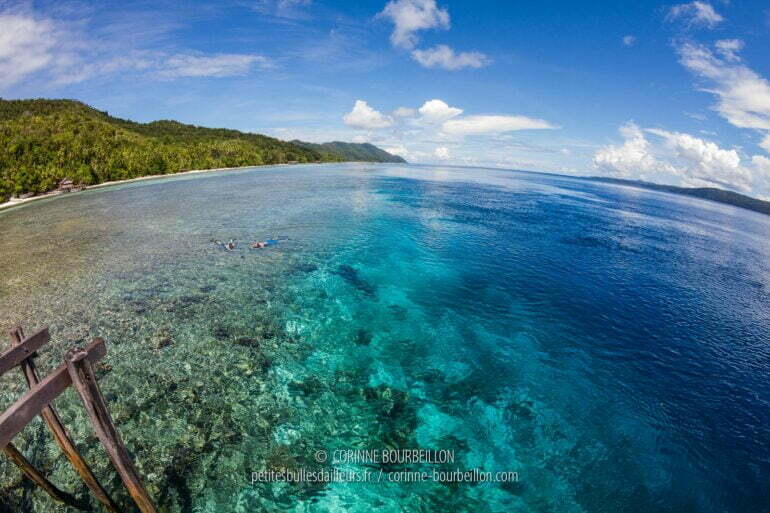

Update [2017]. The fears I expressed above in 2013 have found a sad illustration with an accident that occurred on March 4, 2017 in the waters of Raja Ampat: a large British tourist cruise ship, like a "floating building", the Caledonian Sky, devastated a small portion of a spot known to divers as Cross Over, in front of the northeast coast of Kri Island... 😡 This kind of ship has nothing to do here! To learn more, I refer you to the links below:
→ Indonesia: a ship damages exceptional reefs [fr]
→ Cruise Ship hits Crossover Reef: The Impact on the Reef [en]
→ Saving Raja Ampat waters with tourism [en]
For my part, I returned to Raja Ampat in July 2017, and dived at the site in question. The damage, just in front of the beach (how dare anyone come so close to the coast with such a big boat?) fortunately only concerned a very small area. But underwater, the spot where the boat scraped and smashed the reef, just a few metres down, was all grey and littered with dead coral. It was a stark contrast to the vibrant reefs all around.
2. Where is Raja Ampat?
You have trouble locating Raja Ampat? As I said above, they are islands located in the far east of Indonesia. The archipelago, off the island of New Guinea, is part of the province or region called West Papua (Papua Barat in Indonesian). Here it is:

A little historical-political reminder: the western half of the immense New Guinea Island (formerly colonized by the Dutch) has been annexed by Indonesia in the 1960s (the eastern half became the independent state of Papua New Guinea). At that time, the Indonesian army committed massacres. Nowadays, a Papuan separatist movement continues to take action and the Indonesian authorities do not hesitate to brutally repress any opposition.
In March 2022The Indonesian government's bill to divide Papua into new provinces, without consulting the local population, has provoked a wave of protests, and Papuan protesters were killed by the police. Amnesty International has published a report denouncing the increased repression around the Wabu Block gold mine in the department of Intan Jaya (north central).
In April 2021, military reprisals were launched in the region of Puncak after the death of the head of the intelligence services during exchanges of fire with Papuan independence fighters.
In August 2019, violent riots broke out in Manokwari, Sorong and Fakfak, after the arrest of Papuan independence students in Java, against a backdrop of racist tensions: the government then cut off the internet in Papua and sent a thousand soldiers there as backup.
In July 2017almost twenty years after the Biak massacre (1998), the Indonesian military and police have carried out mass arrests in Nabire and Sentani, whilea petition for West Papua was attempting to bring the Papuan voice to the international stage that same year.
I close this parenthesis, but when you go there as a tourist, you have to be aware that the region is unstable and not quite a "paradise" for everyone...
Most travelers access Raja Ampat via Sorong airportin front of the islands. Sorong is a mining and industrial port, without much charm, with about 260,000 inhabitants today, where one of the scourges affecting Indonesian waters is clearly visible: plastic pollution.
(On this theme, I invite you to read this article, published by the Tara Foundation after a stopover there by the scientific schooner in late December 2017 → Indonesia: the ocean is suffocating under plastic)
Sorong is located on the "beak" of the tip of West Papua, aptly nicknamed the "Bird's Head Peninsula". (Bird's Head Peninsula in English) because of its form.
When you fly to Sorong, it looks like this:

In WasaiWaigeo, the large island in the heart of the Raja Ampat archipelago, off Sorong, a second airport was inaugurated in May 2012 (read also here : Raja Ampat gets a new airport). From 2014, it was apparently possible to make the Sorong-Wasai crossing by air, via small cuckoos with propellers chartered by the local company Susi Air. But in 2016, it was reported to me that the Marinda de Wasai airport was not really operational and was only rarely used, during official visits...
Wings Air (a subsidiary of Lion Air) attempted to launch a Manado-Wasai flight. But now that Sorong airport has been expanded and modernized, Wasai doesn't seem destined to become the new air gateway to Raja Ampat that it was originally intended to be. announced by President Joko Widodo after his 2016 visit. The Wings Air route called "Manado - Raja Ampat" that I've already spotted on the information screens at the airport has accumulated delays and/or cancellations since its launch, and was finally suspended during 2018...
On the other hand, the Sorong airport has been transformed: it has been completely refurbished and expanded! As a result, the archipelago, which had long remained off the beaten track of so-called "mass" tourism, is seeing a year-on-year increase in the number of foreign and Indonesian visitors. For example, in diving tourism: from a dozen liveaboards (dive cruises) in the early 2010s, we've grown to over a hundred in 2019... 😱
As for tourism in general, since the visit of President Jokowi (Joko Widodo) in 2016.the way in which the Indonesian authorities have started to develop and promote the destination (especially on social networks with the keyword #lastparadise) scares me. For example, on the island of Piaynemo I mentioned earlier, lots of new stairs, signs and platforms (including one with a giant heart) have been installed everywhere. Big white Hollywood-style letters, claiming P I A Y N E M OSome of them have even been hung on a karst cliff at the entrance to the bay... A horror especially dedicated to Instagrammers, I suppose. And it's not going to get any better with the new Bali-Denpasar air service (3-hour direct flight) launched by Garuda at the end of 2023.
To read (in English) → Infrastructure Development to Boost Tourism in Raja Ampat
In short, I fear this is the beginning of the end. I realize with a twinge that the relative tranquility of Raja Ampat that I knew and its protective isolation are now a thing of the past... 😢
Below, some peaceful pictures of landscapes and people, dating from the years 2010...
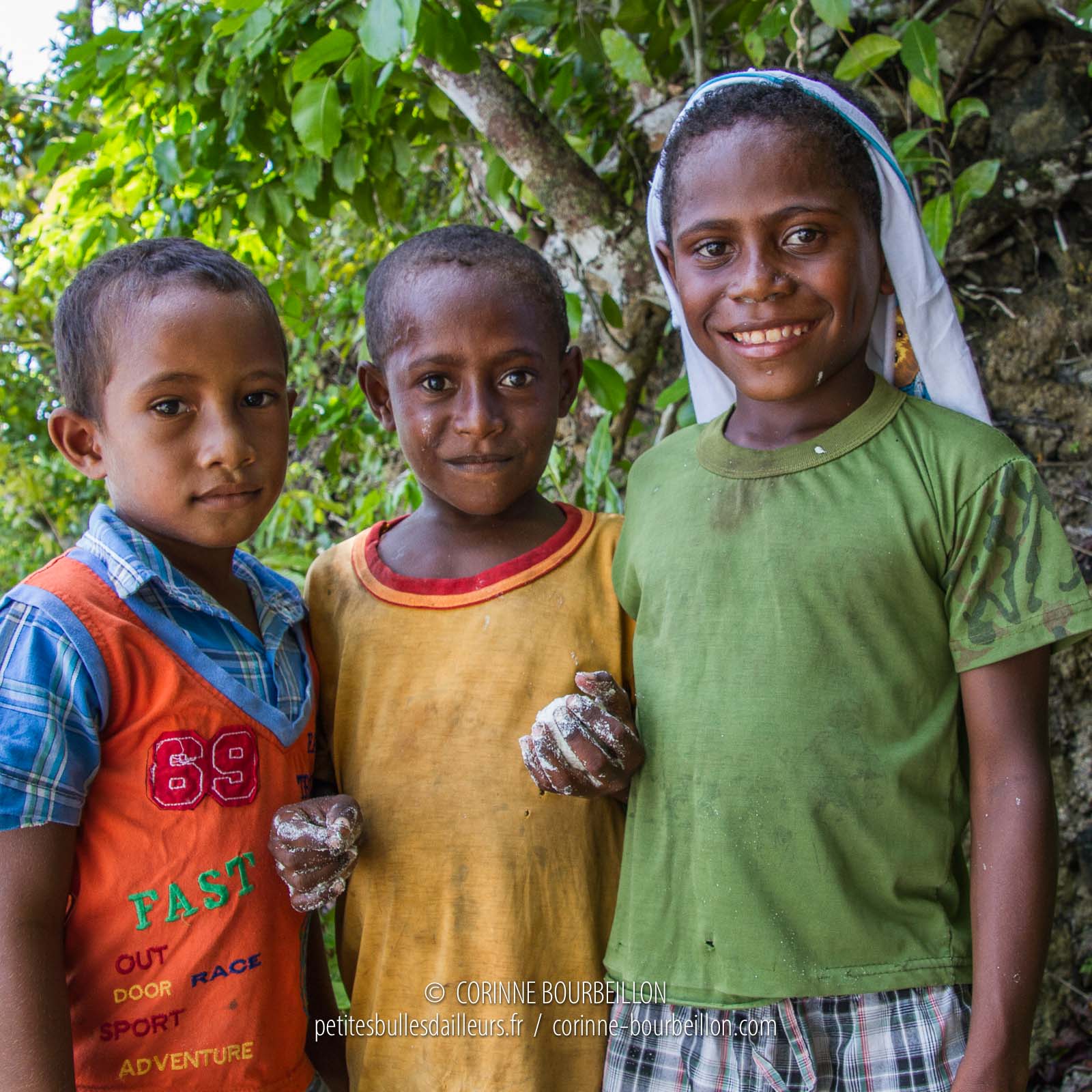

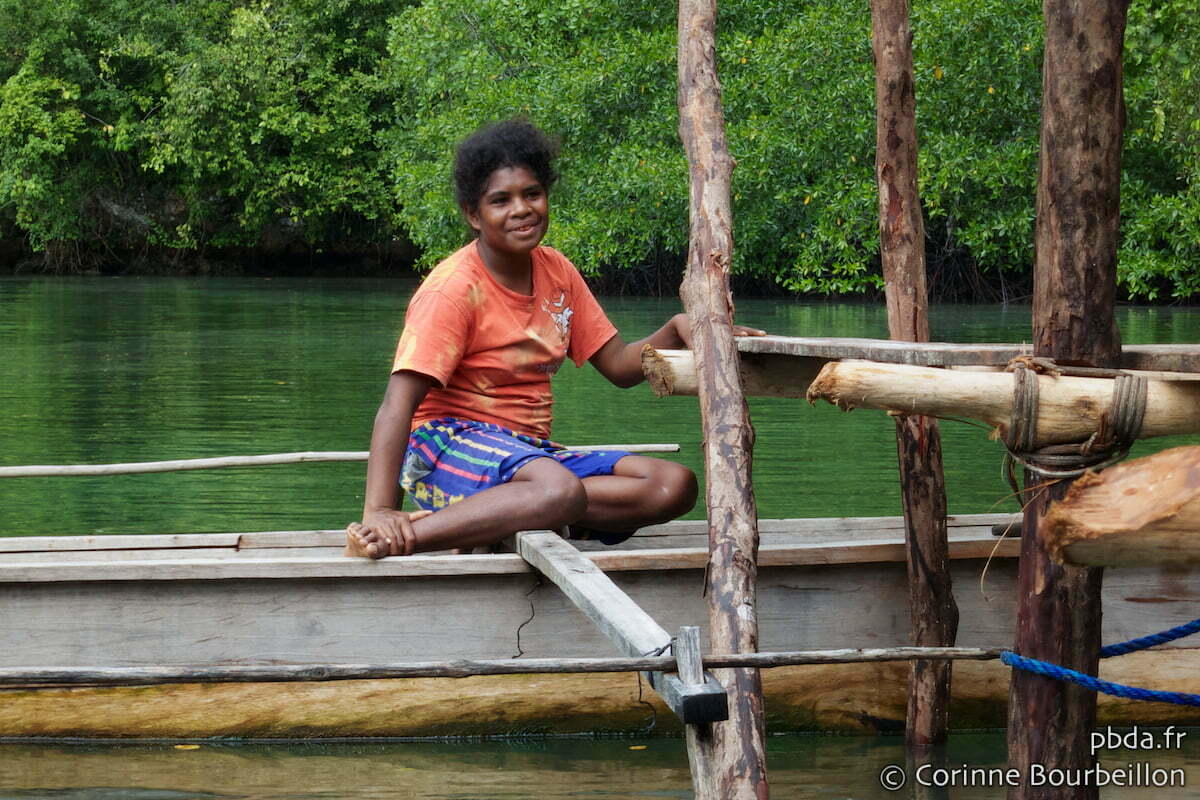
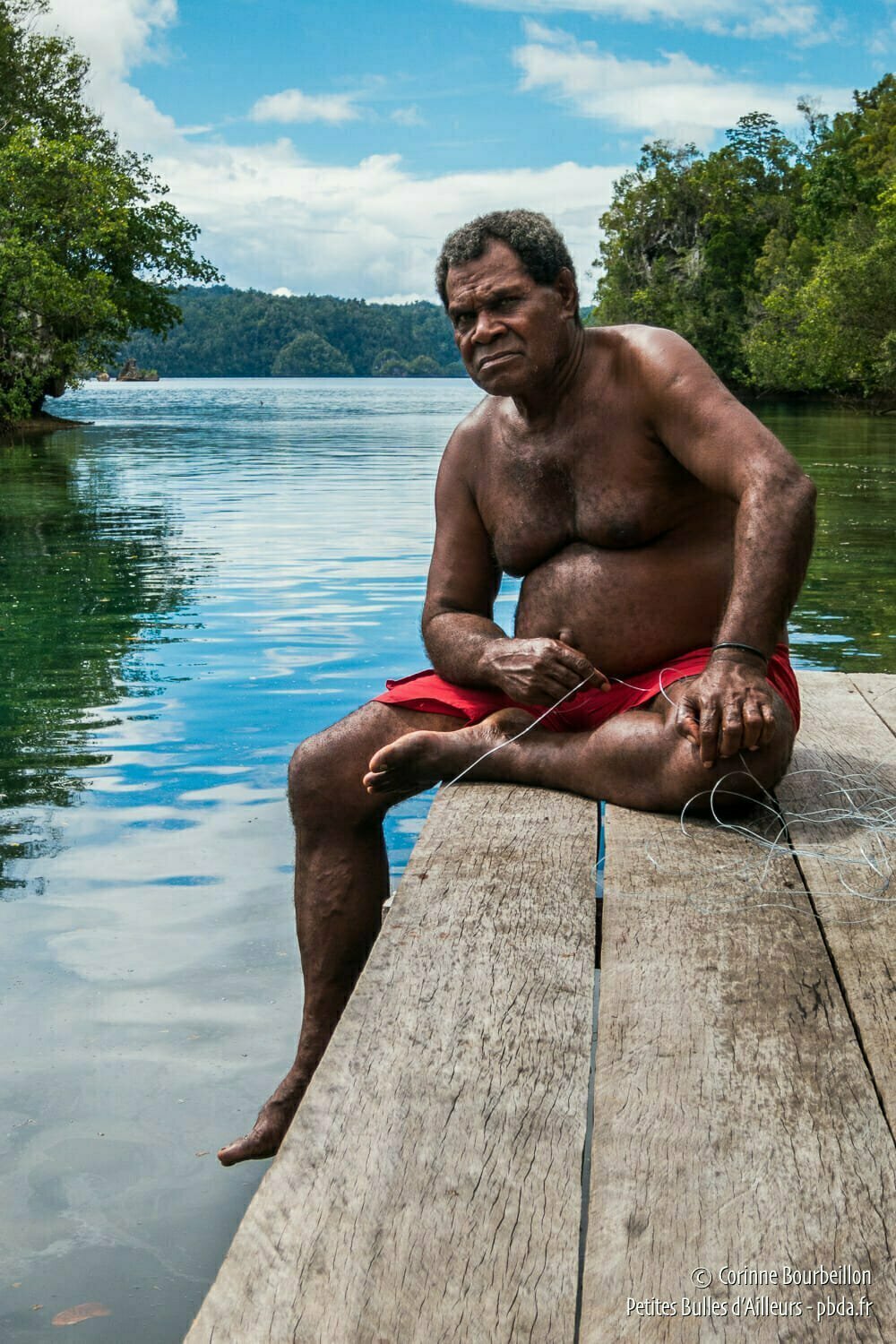

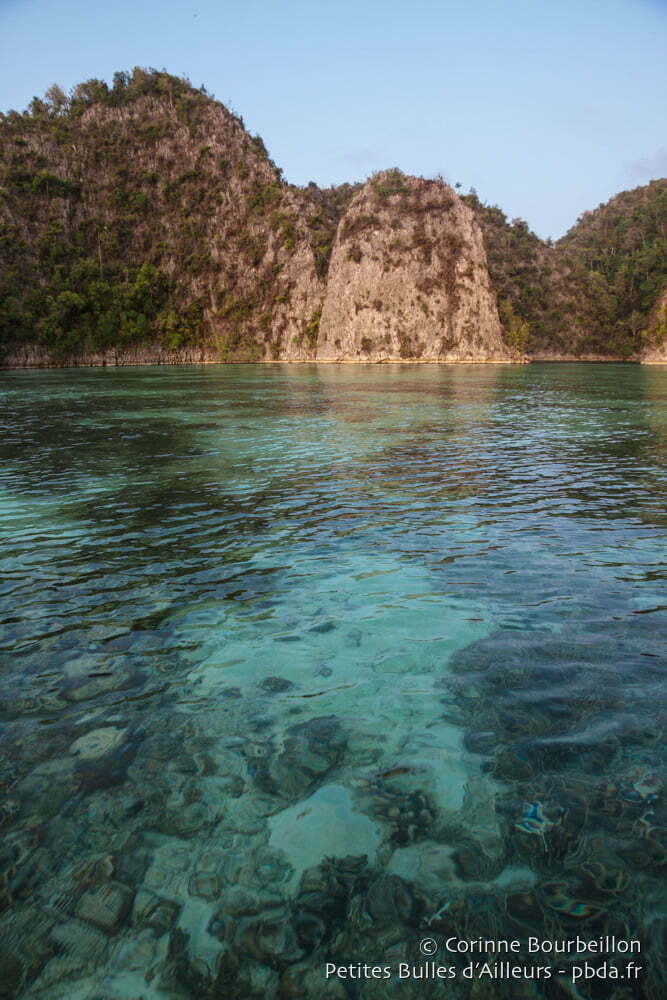

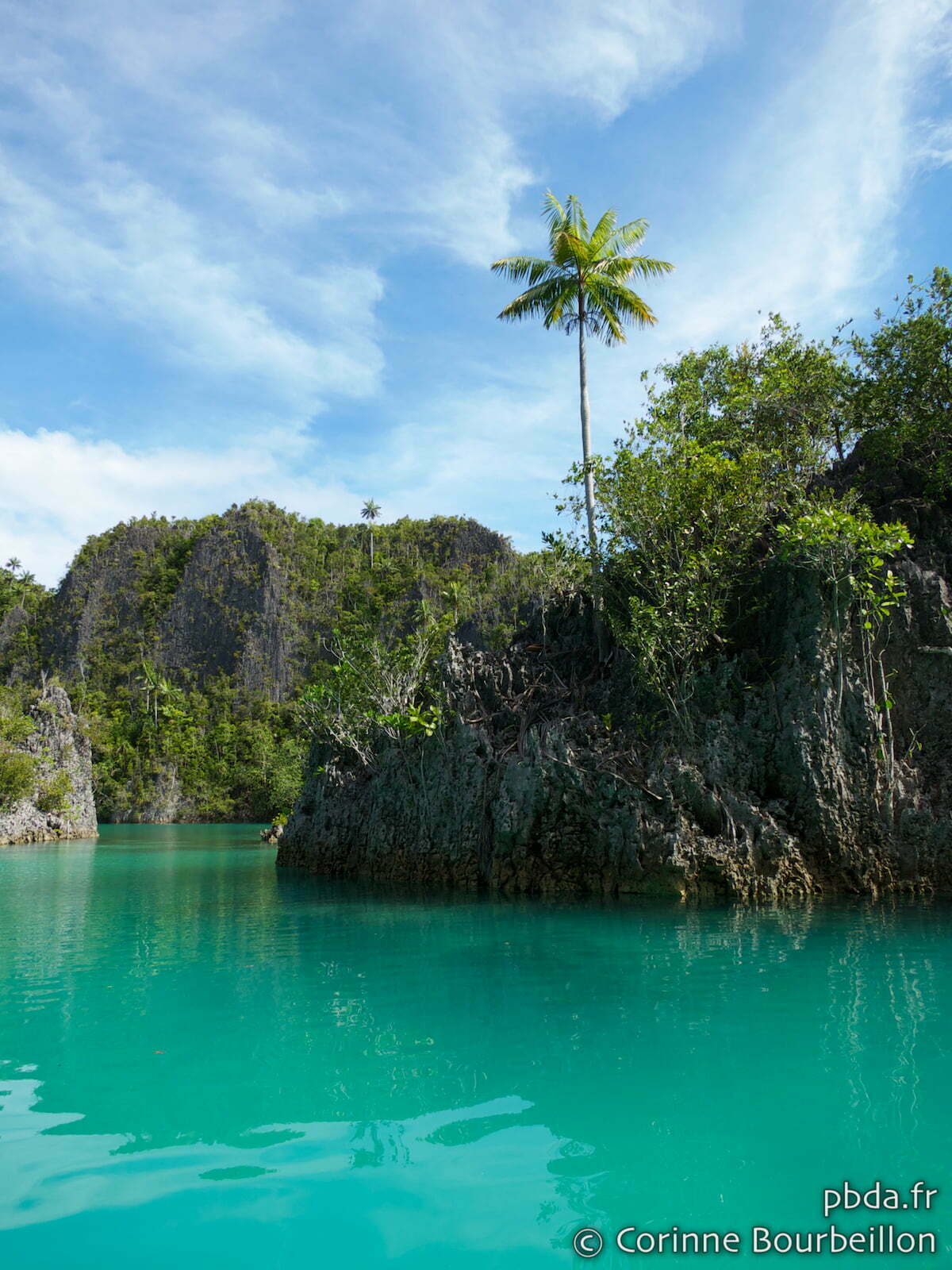

3. I am not a travel agency
I'll allow myself a friendly warning, before I go any further: I get a lot of messages from people who mistakenly think I'm a travel agency or a tour operator's agent... Some even send me booking requests!!! 😂 It's crazy...
I have nothing to sell and I do not organize trips. To clear up any misunderstanding, I blog here about my travels and my dives for fun, without any commercial motivation, and nobody pays me to do it. (click here to find out more about me).
Concerning hotels, tour operators, diving centers I mention: I absolutely cannot give you their prices nor their availabilities... If you need information on their prices, their services, etc. ask them directly! All of them have a contact page on their websites.
Also be aware that everything changes very quickly in this region of West PapuaRaja Ampat, which is currently undergoing rapid tourist development. This article was first published in 2013, but I continue to update it as the years go by and as I make new diving trips to Raja Ampat (I updated it again in 2024).
Finally, take the time to do your own research. The laziness of some aspiring travelers sometimes amazes me... We live in a great time, where everyone has access to a free tool, very efficient, updated in real time, called Google. 😜 And now you can even ask for advice from ChatGPT.
4. My previous trips to Raja Ampat
Unlike countless purveyors of advice on social networks, I don't claim to offer here the "ultimate" guide to Raja Ampat, nor to sell the destination as "the last paradise"... As I said earlier, things change so fast out there! It won't be long before, with the growing influx of Indonesian and international divers and tourists, nothing will be quite the same.
I've already seen some noticeable changes, between my first diving trips to Raja Ampat in 2012 and the most recent (July 2019 and December 2023)... And I've already published quite a few articles for you to refer to on this blog. You can always find them here, at the end of these links:
→ Travel Raja Ampat + Bali: March 2012
→ Travel Alor + Raja Ampat: July 2012
→ Raja Ampat trip: January 2015
→ Banda Cruise + Raja Ampat: October-November 2015
→ Travel Komodo + Raja Ampat: July 2016
5. When to go to Raja Ampat for diving?
Good news: you can dive all year round in the north of Raja Ampat (the islands around the Dampier Strait, off Sorong). But to optimize your stay, there are subtleties to know about the climate and weather of this region, West Papua, which differ from the rest of Indonesia.
Normal, we are not really in Asia, but in Oceania...
- October to April: this is considered the best time to dive anywhere in the archipelago, and is the peak tourist season. Corresponding to the north-west monsoon, this season is often described as "dry" by tour operators. In reality, it can still rain quite heavily (especially in December and January). No, the real difference with the so-called "wet" season of May-September (southeast monsoon) is the low wind and swell (in principle). Conditions are therefore ideal for sailing, and it's high season for dive cruises. It's also a period when plankton proliferates: underwater visibility is less good (sometimes rotten), but you're more likely to encounter manta raysand to see them form a spectacular ballet at the most spectacular sites in the world. Manta Sandy and Manta Ridge (alas, since 2015, they've been seen less often there, as the sheer number of boats, snorkelers and divers has scared them off; now access to these sites is regulated, which seems to improve things a bit).
- May-June: a bit of a tourist slumpIt is therefore a good plan for divers to go there at that time, because resorts regularly offer interesting promotions on their "accommodation + diving" packages.
- May to September: diving is possible in the north of Raja Ampat, but not in the south. We're under the influence of the south-east monsoon, known as the "wet" season (but in terms of rainfall, there's not much difference with the "dry" season from October to April). In fact, what distinguishes the two seasons, as I said earlier, is the wind. Between mid-May and mid-September, it can blow quite a lot, with very rough seas... If you're based ashore on an island in the northern archipelago, there's no need to worry about diving at nearby sites, but more distant outings will depend on the weather and the swell (which is why there are few, if any, organized cruises during this period). On the other hand, the south of Raja Ampat (Misool and the surrounding area) is very exposed to winds from May to September: it is therefore difficult, if not impossible, to sail and dive there during this period. Manta rays are also becoming rarer, as there isn't as much plankton near the surface, but underwater visibility seemed better overall (check out the video I made here in July 2016).
- So, when is the weather? Whatever the season, the skies are very changeable in Raja Ampat. It alternates between bright sunshine, grey skies and rain in almost equal measure, as far as I've been able to judge during my various stays (in November, December, January, March, July), whether under the influence of one monsoon or another. Showers are often very localized. It's not uncommon to see a big cloud pouring down curtains of rain on an island just a few kilometers away, while the island you're on, for example, is bathed in sunshine... To go diving in the rain and come home to blue skies (or vice versa).
- The air temperature is stable (25°C at night, 30°C during the day), the water temperature is constant, around 28°C. We're at the equator, so basically it's always hot and humid. The climate is truly "equatorial" all year round, with no major seasonal variations, apart from the wind I mentioned earlier. After that, weather isn't an exact science, and the climate can go haywire. So you can have a rotten week. Or several days in a row of great weather. Or not. Or have both seasons in the same day...
6. How do I get to Raja Ampat?
STEP 1: Fly to Indonesia
To get to Raja Ampat, you'll first need to organize your trip to Indonesia, or to a neighboring country with convenient connections to Indonesia (e.g. Bangkok in Thailand, Kuala Lumpur in Malaysia, or Singapore). Obviously, given the enormous carbon impact of air travel, it's best to try and optimize your stay for a longer duration.
- PRICE. Count 450 € to 900 € (according to promotions, airlines and seasons) for a dry flight from Paris to Jakarta and back. (at least that was the price range before Covid; prices have soared since). To this must be added the cost of the domestic return flight (Jakarta-Sorong or Denpasar) Sorong, from 150 € to 300 € (idem, these are pre-Covid prices, they must have gone up a lot, so do your own research).
In Indonesia, Raja Ampat is part of the province now called Papua Barat (West Papua)As I explained above, formerly Irian Jaya (name first given by the Indonesians).
It is far, very far, in the extreme east of the country, opposite the capital Jakarta. Don't forget that Indonesia stretches over three time zones, it's huge... When you take off from Europe, the journey to Sorong can't be done in one go!.
- TRAVEL TIME. Therefore, count at least two days (Paris-Jakarta flights, then Jakarta-Sorong, then the crossing by boat) to reach Raja Ampat from France. This represents, counting the outward journey and the return journey, a total of four days! A very long trip... To make it worthwhile, plan to stay enough time in Raja Ampat and/or combine the trip with other destinations in Indonesia.
STEP 2: Organize the trip to Sorong
SorongSorong, in West Papua, is the gateway to the Raja Ampat archipelago. To reach Sorong from the Indonesian capital Jakarta, there are several possibilities (I updated the info in August 2019, before the Covid pandemic). I therefore advise you to check directly with the companies, on their websites, as many things must have changed since then:
- DIRECT FLIGHTS. The duration of a flight from Jakarta to Sorong is approximately 4 hours. Before Covid, three companies offered direct flights: Batik Air (subsidiary of Lion Air), Garuda Indonesia, and, since September 2019, AirAsia (Malaysian low-cost airline with subsidiaries throughout Southeast Asia). Xpress Air, which pioneered this route, no longer operates. Nam Air (subsidiary of Sriwijaya) direct flights, launched in 2015, no longer exist since the end of 2018 (Garuda bought Sriwijaya / Nam Air via its subsidiary Citilink and is gradually taking over their routes). I've already flown several times without worry with all the companies I mention (reservations made on their websites from my home in Brittany with my French bank card without any problem). Make sure, when you book, that you choose a direct flight (in the list, there are also flights with stopovers).
- FLIGHTS WITH STOPOVERS. Lion Air, Batik Air, Sriwijaya / Nam Air and Garuda operate the domestic Jakarta-Sorong route with a stopover, usually on the island of Sulawesi, either at Manado (the big city in the north), or to Makassar (the big city in the south, also called Ujung Pandang).
- DIRECT FLIGHTS FROM BALI. New since late 2023: Garuda has opened a direct service from Denpasar-Bali airport (approx. 3-hour flight) twice a week.
Makassar and Manado on the Indonesian island of Sulawesi are the two main Indonesian air hubs for Sorong. These airports are easy to reach by domestic flights, whether from the capital Jakarta or from Bali (Denpasar airport).
Makassar and Manado can also be reached by international flights from the air hubs of neighboring countries: Kuala Lumpur in Malaysia, for example, or Singapore.


How do I find domestic flights?
Very practical to do your little research: the site Nusatrip.com (it is a bit like Skyscanner for domestic flights in Indonesia). You can also book your tickets there, but for my part, whether in Indonesia or in France, I always prefer to go on the website of the company I found and book directly at the source rather than going through an intermediary.
Below are links to the websites of the various airlines, where you can check schedules and availability, and book your ticket online with a credit card, even from France (which wasn't always possible a few years ago). I've tried them all at least once, with success. But please check that the information below is still up to date...
- Jakarta-Sorong flight direct: non-stop connections are offered by Lion Air, Batik Air, Garuda Indonesia and AirAsia.
- Flight Denpasar (Bali)-Sorong direct : a new twice-weekly service was launched at the end of 2023 by the Garuda.
- Flight Jakarta-Sorong with stopover: the Garuda and Lion Air / Batik offer connections, there is usually a stopover in Manado or Makassar, sometimes Ambon or other... See if Sriwijaya / Nam Air still offers flights with a stopover.
- Flights to Makassar or Manado: from Jakarta, Bali-Denpasar, Kuala Lumpur, Singapore: there are plenty of possibilities on the sites of the companies Air Asia, Garuda, Sriwijaya Air, Lion Air, Silk Air (affiliate Singapore Airlines), etc.
- Manado-Sorong flights: the Garuda now has a link, in addition to those of Lion Air (or its subsidiary Wings or the associated company Batik).
- Makassar-Sorong flights: I have already flown with Sriwijaya Air and with Garuda... Now check the existing offers at Lion / Batik too... The people who run hotels and resorts in Raja Ampat are usually well aware of the changes in air links, ask them.
⚠️ Beware, there are often changes in schedules and connections domestic flights. At the time I published this post, Batavia Air went bankrupt (I had to sit on my ticket and find another flight) and Xpress Air cancelled their flights (before resuming them, and then cancelling them again)... Always check the day before departure if you can that the schedules have remained the same (I once had a take-off one hour earlier, without being warned!). You should also know that some delays one to two hours are often the norm in Indonesia.
⚠️ A source of confusion for many travelers: Makassar is often referred to by his other name, Ujung Pandang, on the online booking sites. Think about it when you do your research ...
⚠️ Note that you may need to plan a night in Makassar or Manado. Good to know: there is an Ibis Budget in the airport of Makassar, to get a few hours of sleep, before the takeoff at dawn of most flights to Sorong. I slept there several times...
⚠️ If you don't feel like booking the domestic flights yourselfIf you can't find the airline you're looking for, or if the airline's website doesn't work - there are sometimes bugs or security problems on Indonesian websites - you can always ask the hotel or diving center you'll be staying at to book the domestic flights for you, or to give you the contact details of a local agent. Alternatively, you can book your Indonesian flights on the Nusatrip.comwhich I mentioned earlier (I haven't tested it myself). Below you'll find links to diving resorts of Raja Ampat. They all have an explanatory page How to get there indicating flights to Sorong and possible routes to organize your trip. Finally, if you don't feel like taking care of this at all, the easiest thing to do is to turn to a diving tour operator, who will organize the whole trip and stay according to your wishes.
7. Don't forget the permit
There is an entrance fee to visit the Raja Ampat Marine Natural Park: it is 700,000 Indonesian rupiahs (about 45 €) for foreign visitors since 20 December 2019. See the page Entry Permits on the new official website Raja Ampat Marine Parkpage, or the Raja Ampat Marine Park entry permit on the excellent site Stay Raja Ampat, which is a valuable source of regularly updated tourist information on the region. If you find different prices on the internet, it's normal, as there have been several price changes over the years.
This permit is valid for one year from date to date. You are given a plastic card indicating this validity period, with your name and passport number written on the back. In the past, divers were also given a badge to hang on their stab.
If you have organized your trip to Raja Ampat with an official diving structure (resort, cruise), don't worry about it. Hotels and tour operators purchase it in advance for their guests (homestays are not allowed to do so and cannot provide this service). The amount is then added to or included in your bill and the permit is given to you by the hotel or boat staff at check-in.
If you are an independent traveler planning to stay in a homestay: it is up to you to obtain this permit. There have been several changes in the last few years. There are now two official offices for revoking one's license: one in Sorongat the port (Bintang Marina), and one in Wasai (where the ferry docks on the island of Waigeo). I give you below the link of the Stay Raja Ampat website which compiles all this information, and which is regularly updated, as well as the link to the official website of the Raja Ampat marine park...
➜ Raja Ampat Marine Park Entry Permit
➜ Where to buy your Marine Park Entry Card
⚠️ Tip: Make sure you pick up your license at an official office.Don't buy it online or from people who might approach you when you get off the ferry. You risk paying more and/or being given a non-valid permit... In short, beware of scammers!
This entrance fee is intended to finance ecological actions in the protected marine area, to feed a local community fund (70%) and to support the development of the region (30%). Below is a small graph (from before 2020, when the fee was 1 million) indicating where the money goes:
NO NEED TO SURAT JALAN. Finally, I specify it here because I am often asked the question (valid information to date, to my knowledge): no, you do not need another permit called Surat Jalanto simply go to Sorong or Wasai and do some tourism in the Raja Ampat archipelago. The Surat Jalan is only required to travel elsewhere in vast Papua, particularly in areas deemed "sensitive" by the Indonesian government, which is not too keen on journalists, in particular, taking too close an interest in the region and the crackdown on Papuan independence fighters... To read on the subject, this article (from 2015) by Human Rights Watch:
→ Indonesia: removing barriers to access to Papua
8. Diving resorts
Note: when I use the word "diving" here, I'm talking about scuba diving with bottleno swimming with flippers, no snorkeling (called PMT in French or snorkeling in English), which can be practised almost anywhere you like. Always exercise caution before getting into the water: make sure you know about currents and tides, which can be treacherous... Just because the sea is turquoise and lined with coconut palms doesn't mean it's any less dangerous.
For diving in good conditions of comfort and safety at Raja Ampat, being based on land...In my opinion, it's best to contact one of the local diving resorts, or a "real" diving center. Incidentally, I've noticed that the English term resort (a tourist complex providing services other than just accommodation) was not very familiar to French speakers. In short, resorts here are simply hotels (often bungalows facing the sea) that double as diving centers.
Compared to the diving cruises, this is the option that I prefer. Why? On the one hand, the guides of the diving resorts often know the sites of Raja Ampat much better than those of the cruise ships. On the other hand, the structures based on the spot are often more involved in the local environmental programs, and much more concerned by the protection of the marine park than the cruise operators, who, them, only pass the time of the high season...


Beware, diving resorts in Raja Ampat are not cheap. and generally speaking, the rather high prices charged for tourist services in the archipelago have nothing in common with the rest of Indonesia.
As a result, many budget-conscious tourists choose to take the plunge with homestays, simple, inexpensive accommodations run by Papuan families. (often simple huts with mattresses and mosquito nets). Beware: more and more dive resorts are offering bottle diving as part of their activities, but without necessarily having the necessary authorizations, skills or equipment in good condition... Dive resorts, on the other hand, usually have well-maintained equipment and compressors, trained guides, suitable boats and certified instructors for training courses (Padi, CMAS, SSI, etc.).
So I can't recommend you highly enough cautionif you decide to dive with a homestay. It is better to come with your own equipment, to check the condition of the compressor and especially to be an autonomous diver, or even a seasoned one, with experience in currents. If you read English, I invite you to read the warnings on this subject on the site StayRajaAmpat, who go in the same direction → Diving with Raja Ampat homestays
As an alternative to resorts, there is theArborek Dive Shopa small local diving center located on the island of Arborek. It allows you to dive for less and works for the accommodation with the homestays of the island (see page on StayRajaAmpat). The Arborek Dive Shop has a very good reputation. I did not test it myself, but everybody told me good things about it, from tourists and divers to the staff of different resorts in Raja Ampat... It is run by two passionate people, Githa (whom I met) and Marsel, who are very involved in environmental programs to preserve the reefs and fight against pollution. To contact them : the Facebook page Arborek Dive Shopthe e-mail arborekdiveshop@gmail.comor WhatsApp at (+62) 822 3873 4552.
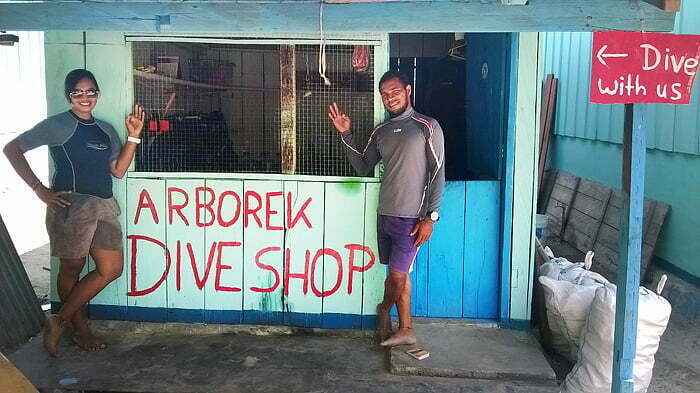
The diving center Soul Scuba Divers on the island of Kri also has a good reputation. I haven't tested it myself. French is spoken here, and budget accommodation is available in nearby homestays. It also offers divers the chance to discover the remarkable coral restoration work carried out by the association Orang Laut - The SEA People.
For my part, as a diver photographer traveling with the bulky equipmentI loved the comfort, the service and the setting of the beautiful Sorido Bay Resort. Really the great luxury, in these countries. I went there twice in 2012 when I was discovering Raja Ampat, and I went back several times afterwards. As the Kri Eco Resort Sorido is ideally located on Kri Island, in the Dampier Strait, where the most famous dive sites are concentrated.
These two resorts are managed by the company Papua Diving. They were created by the pioneer of diving in Raja Ampat, the Dutchman Max Ammera hell of a character !

Other experiences... My sister, who is not a diver, tested Raja4Divers about ten years ago, and she loved it. Marc and Isa, a couple of adventurous divers, previewed Raja Ampat Dive Lodge in 2009 and they liked it very much. Anne-Sophie and Marco, another couple of diving travellers, were delighted with their stay at Papua Explorers in 2014and then the one they made in Papua Paradise in 2016 (their only regret for this resortment, as divers, was its remote location in relation to the Dampier Strait where the most famous spots are located, but in compensation Emma the dugong visited them, and afterwards they even worked for this resort for a year).
Here is the list of diving resorts that exist, to my knowledge and to this day (I keep this list pretty much up to date over the years):
- Kri Eco Resort (by Papua Diving, on Kri)
- Sorido Bay Resort (by Papua Diving, on Kri)
- Papua Explorers (on the south coast of Gam, opposite Mansuar)
- Raja Ampat Biodiversity Eco Resort (on the northeast coast of Gam)
- Raja Ampat Dive Lodge (by Grand Komodo, on Mansuar)
- Raja4Divers (on Pef, northwest of Gam)
- Papua Paradise (on Birie, near Batanta)
- Cove Eco Resort (on Yeben, near Piaynemo, a diver-photographer friend who always gives excellent advice spoke very highly of it).
- Agusta Eco Resort (on the islet of Agusta, south of Mansuar)
- Waiwo Dive Resort (on Waigeo)
- MahaRaja Eco Dive Resort (on Dokri, near Batanta)
- Meridian Adventure Dive Resort (on Waigeo, near Wasai)
- Yenatar Resort (on Gam)
- Misool Eco Resort (very luxury, located in the south of Raja Ampat, in Misool)
- Lalelkai Nature Lodge (in the south of Raja Ampat, at Misool)
9. Diving cruises in Raja Ampat
Diving cruises are an interesting option for discovering a wider variety of sites and islands in Raja Ampat, over longer distances. But the quality of the dives may suffer: the guides on the boats do not always know the sites as well as those who are in the resorts all year round...
Short or long cruises, North and/or South... There are more and more operators, more and more choices. Don't necessarily go for the most attractive price and check out the divers' forums beforehand, to know what to expect and if you will get your money's worth. "You get what you pay for..." There are generally "short" cruises (5 to 7 days, itinerary in the north of the archipelago only, departing from Sorong or Wasai) and "long" cruises (10 to 20 days, including an itinerary to the south around Misool, or even as far as Kaimana and Triton Bay).
It is also important to be aware that the increasing number of diving cruises in Raja Ampat has a big impact on the coral and reef fauna. This is starting to become problematic in recent years, with the influx of boats and divers on the same sites... When I visited Raja Ampat in July 2016, a quota project, to limit the number of vessels present at the same time in the different protected areas, was under consideration. The installation of buoys for moorings (in order to avoid that the boats do not massacre the coral funds by throwing the anchor) is in progress.
Dive cruises are organized between October and April.This is the best time to sail in the area, as I explained above.
In March 2012, I had made a short cruise in the Northern Archipelago with the boat Black Mantawhich belonged at the time to the company White Manta Diving(But this ship has since been sold and is now chartered by another operator who no longer offers the same services...)
During my cruise, it was a Frenchman, the adorable and very competent Cédric Lesénéchal, who was the cruise leader (He then officiated several years on the boat Blue Manta, more recent, from the same company). Below some pictures of this cruise…
- To locate dive cruises at Raja Ampat (and elsewhere), you may use the site First Liveaboard Diving. He is bound by Jez Trynera sub photographer based in Bali, who acts as an intermediary with the operators. I don't know him personally, but I used his services in 2012 and I was very happy. We had exchanged by e-mail to settle a lot of details, he was very responsive, very nice. Otherwise, in the same style, there is this website which is also very good to find the availabilities: Liveaboard.com
- If you are not comfortable in English and prefer to speak to a French intermediaryMost of the big, well-known French-speaking diving tour operators have Raja Ampat cruises in their catalogs, so I'll leave you to find out for yourself. Wallacea Dive, a long-established French operator in Indonesia, now also organises cruises in Raja Ampat.
- Update. In the "dream" category, there was the magnificent and luxurious Waowthe aptly named boat... In November-October 2015, I was lucky enough to be able to embark for a fabulous diving cruise aboard the Waowfrom the Central Moluccas to Raja Ampat (departure from Ambon, arrival at Sorong). But this boat designed by and for divers no longer exists: it burned and sank at the end of January 2018. The owners had temporarily chartered another yacht, the Mutiara Lautto continue operating cruises, and were planning to launch a Waow 2… To be continued.
10. Sorong Hotels
In Sorong itself, there are not many hotels. The best known has long been the I Meridien which has nothing to do with the chain that bears almost the same name. This is where you used to come to get your "tag" for the entrance fee (see above).
Since the first edition of this article, the accommodation options in Sorong have expanded. There is not an insane choice, but most travelers spend only one night there, on arrival and/or return. Among the most comfortable I can suggest, having tested them all: the Belagri, the Swiss-Belhotel, the Royal Mamberamo, the Aston (the latter is right opposite the airport, very convenient).
11. Cheap accommodation on the islands of Raja Ampat: the homestays
The islands of the archipelago are now home to a host of "homestays". as I mentioned above. These are not quite homestays as the expression suggests, but accommodations for tourists built by families in the area.
Most often, they are simple huts made of wood and palm leaves, in the local fashion, with very rustic comfort: a mattress on the floor, a mosquito net, and shared sanitary facilities. It is also possible to stay in homestays in the heart of a village, such as that of the island of Arborek (near the mantas-rays site).
For these very simple accommodations, the rates are around 500 000 to 800 000 IDR per day (30 to 50 €) in fullboardThis means three meals per person.
It is quite complicated to book in advance or to contact people through the internet (connections are rare in Raja Ampat outside of the resorts, and there is no mobile signal everywhere). But once in Sorong or Wasai, you can easily get information and contact people on the spot, via the small tourist office and the homestay office in Wasai or by SMS. It is a nice option for budget travelers, which allows to favor the local Papuan population and to meet the inhabitants of Raja Ampat.
Here are some useful links (I edit the list regularly, as I find new information on the web):
- Budget accommodation in Raja Ampat on the excellent site Stay Raja Ampat who is packed with useful information for independent travelers on a budget. The site is updated very regularly... You can see bungalows on the islands of Kri, Mansuar and Arborek. Take the time to read the comments below, to have fresh information from travelers about the welcome and the behaviour of the homestays, it can be very variable, some of them have deteriorated from one year to the other and some travelers come back disappointed (presence of rats, monotonous and insufficient food, dilapidated diving equipment, etc.).
- Very interesting and detailed account of a stay in Raja Ampat in homestays (Kri, Mansuar, Arborek, Gam) (May 2017 stay, by photographer Marion Staderoli, who gives lots of info on several homestays and her snorkeling impressions, with photos)
- Opinion on the comfort conditions at Yenkoranu Homestay on Kri Island (March 2017 review by snorkel enthusiasts)
- Stay-dive at homestay Yenkoranu on Kri Island (stay of November 2013, thank you to Fabien for this very complete and very interesting report, published on Plongeur.com)
- Logistics for Raja Ampat on a budget (blog post, with lots of practical info, from July 2013)
- Trip report: Diving Raja Ampat on a Budget, October 2012 (dive report with local homestays on the Scubaboard forum)
- Raja Ampat on the site East Indonesia (which is a little dated but very complete) by Laszlo Wagner, a Hungarian who is a great connoisseur of the region, and author of, among other things, a phrasebook of Indonesian for Lonely Planet (on its site, click on the tabs on the side to have detailed information on each island).
- Raja Ampat: can be done on a budget (July 2012) (interesting report from low-budget travelers who went to Wasai, on the ThornTree Forum from Lonely Planet)
- Baliem Valley + Raja Ampat (Homestay Koranu Fyak) (Travel report on the Globe-Trotting blog)
12. Kayaking and nature
Looking for a real adventure in the wilderness? For sporty adventurers who aren't afraid to paddle, I invite you to discover the great project Kayak4Conservation.
Supported by Raja Ampat Research and Conservation Center (RARCC), this program aims to help the local population, by organizing kayak tours for tourists a bit adventurous.
You rent a resin kayak (made on the spot) and you paddle to beaches where you can camp, or to homestays installed in fabulous places in the heart of the archipelago, far from everything... Different itineraries, pre-established on a map, are possible.
13. Getting around the archipelago
There are no regular connections between the different islands of Raja Ampat, except the ferry Sorong-Waisai which allows to reach the big island of Waigeo. To circulate in the archipelago is thus a little complicated. I guess you can charter your own boat from Sorong or Wasai for a day or more. But you have to be a bit resourceful, good at negotiation and know exactly what you want...
Diesel is expensive, renting a boat with a guy to sail is very expensive. and rates are sometimes a little "customer-driven". Independent travelers, get together!
Otherwise, most homestays offer day boat trips.Rates vary according to distance and services.
The islands look close together on a map, but in reality, navigation takes time. Local boats are slow, and even resort speedboats aren't always that fast. All it takes is a slight sea build-up or an engine failure to double the journey time. For example, the crossing between Sorong and Kri Island (where Papua-Diving's Kri Eco and Sorido resorts are located) can vary from 1 hour 30 minutes to over 3 hours...
Even more, perhaps, than in the rest of Indonesia, it is necessary here to tame the notion of jam karet (bungee time)!

14. Dives not to be missed
My top dive sites in North Raja Ampat : Blue Magic (alas, it has become too crowded and is now known as "Bubble Tragic"), Sardines, Cape Kri (always magnificent, provided you dive at the right time in the right place with a guide who knows the site well), Otdima, The Passage (no longer dived due to the dangerous presence of crocodiles), Mike's Point... 😍
Other spots I like very much: Manta Sandy (when there were manta rays), Sorido Wall, Five Rocks, MioskonCitrus Ridge, Sawandarek, Friwen Bonda... 👌
But there are plenty of other beautiful diving spots! And I don't know very well the area of Misoolin the South, but the little that I saw was sumptuous…
➜ All the articles about my dives at Raja Ampat: one click here!
Raja Ampat is home to 75 % species of hard corals known worldwide, over 1,600 species of fish, 6 of the 7 species of sea turtles, 16 species of marine mammals and 699 species of molluscs... Here, nutrient-rich currents encourage an explosion of marine life, and the word "biodiversity" really does make sense.
As a result, all the sites are full of surprises for Raja Ampat.even those considered the least spectacular. There is always a carpet shark (wobbegong) stashed in a corner, a Pygmy seahorse, huddled in a gorgon, a bench of humpback parrots an ocean manta which tumbles in the blue, a whirlwind of barracudas or a school of jacks that emerges in the current ...
And then there's this permanent, hallucinatory, unique profusion of incredibly varied "poiscaille", which I lazily refer to as "usual tropical fauna" in my notebooks. The coral is just like it: exuberant, splendid, spectacular. Impossible to get tired in a place like this.
We are at heart of the Coral TriangleIt is the epicenter of marine diversity in the Indo-Pacific. These are, by far, the most beautiful and extraordinary coral reefs I've ever seen in my entire diving life.
Really. I'm not just saying that and I'm putting Raja Ampat at the top of my personal top of the Indo-Pacific sites, in front of Komodo and Sipadan !!!
15. A threatened nature
The Raja Ampat islands represent a turning point in my life as a traveler diver. In March 2012, I was so enthusiastic after my very first stay there, that I went back the same year, starting in July. Then I did it again in 2015, 2016, 2017, 2018, 2019, then 2023...
Things are (alas) beginning to change: Manta rays, disturbed by boats and divers, are becoming rarer at the Manta Sandy site. Previously pristine beaches are now littered with cut coconut palms, to make way for new homestays and resorts. Dogs and cats brought to some isolated beaches by homestay owners are a disaster for the surrounding wildlife. And boats now drop groups of tourists off daily on the sandbar at the tip of the island opposite Kri for picnics or sunsets...
The splendid ecosystem of Raja Ampat rests on a subtle balance, which is weakened by our tourist visits.among other things. Through my underwater images, I try to show the splendor of these exceptional coral reefs. To share my amazement at this incredible natural wealth. I hope to educate and empower the traveling divers who dream of exploring Raja Ampat, but who may not really realize how vulnerable this beautiful area is. I am a little afraid that my images will be one day only a testimony of a past era, documents that we will look at to remember all that has existed and disappeared...
Environmental organizations and local associations are working to support the development of Raja AmpatI invite you to visit the links below to discover and support them:
- The SEA People - Orang Laut (French version)
- Raja Ampat Research & Conservation Center (RARCC)
- Misool Foundation
- Raja Ampat conservation programs (on StayRajaAmpat)
- Conservation International
- The Nature Conservancy
- WWF at Raja Ampat
- Barefoot Conservation
- Kalabia Education for Conservation
Take the time to learn about the structure you choose to discover Raja Ampat, to ask yourself questions about the impact of your visit, to ask yourself who will benefit from the money you will spend there, and, of course, make sure that once you are there, you act as a responsible visitor and diver, both towards the inhabitants and the environment.
16. Books on Raja Ampat
For divers, four books to recommend, in English:
- Diving Indonesia's Bird's Head Seascape. By Burt Jones & Maurine Shimlock. The Bible on the subject. I found copies in the bookstore at the airport in Bali. Otherwise, resorts sell it. Very complete, not only for the central part of North Raja Ampat (Dampier Strait), but also for all the other islands, less visited further north, which are more likely to be visited on a cruise, and for Misool in the south, Cenderawasih Bay and Triton Bay.
- Diving Indonesia's Raja Ampat. By Burt Jones & Maurine Shimlock. This is the short and light version of the first one.
- Underwater Paradise: A Diving Guide to Raja Ampat. By Ricard Buxo. A light version there too, for a first approach of Raja Ampat.
- The Raja Ampat - Through The Lens Of ... Beautiful book illustrated by 17 renowned underwater photographers, including David Doubilet, Gerry Allen, Tim Laman, Burt Jones, Maurine Shimlock...
For all, in French:
- At the first morning of the world, edited by Hozhoni, released in October 2018, a splendid book about the expedition to Papua of the Iris Foundation, illustrated by Stéphanie Ledoux.
For a long time in English only, but now available in French as well:
- The Malay Archipelago, published in 1869, fascinating exploration story British naturalist and geographer Sir Alfred Wallace (1823-1913), which I mentioned in this post → The passage
In this year 2022, it is FINALLY published in French translation by Manu Caussepublished by Carrot featherillustrated with beautiful photos of Tim Laman.

Conclusion
- So I don't have any recommendations for "cheap addresses", I don't have a "good plan" for staying on a deserted island or a dream beach, nor a "recipe" for not spending a penny on Raja Ampat. There are plenty of deserted islands, but really deserted ones, with just birds, birds, birds, birds.... couscousthe jungle and the mosquitoes, everywhere in the archipelago. Think rather to preserve this extraordinary nature...
- I live in Rennes, Brittany, I don't know by heart the Indonesian airplane schedule nor the Sorong-Wasai ferry schedule, and I am not affiliated with the Indonesian tourist office. I also don't know exactly how much it costs to stay in this or that place. The best thing to do is to contact directly the hotels and resorts in Raja Ampat, they are always quite knowledgeable about these things... Otherwise, you will have to find out on the spot.
- Weather forecastI am not sure if the weather will be nice from February 28 to March 12. Or if it will rain a lot or just a little from December 10 to 22. I am quite familiar with the humid climate (Breton or tropical), but I am not a meteorologist or Madame Irma.
- Yes, there are mosquitoes in Raja Ampat - no more than elsewhere in these latitudes - and they can transmit malaria. But I can't decide for you if you should take preventive treatment or not. I am not a doctor and it is up to each person to take responsibility for his or her health. I invite you to read this excellent article published by François of the blog Tourdumondiste, which explains everything very well, with serious information (sourced) and advice → Should I take malaria medication when travelling?
If after that, you still want to discover Raja Ampat, because you like the wild and preserved nature, the slow and distant travels, the lost and isolated islands, the tropical and abundant underwater fauna, and you can afford to break your piggy bank, don't hesitate: you will come back dazzled...
Indonesia: Bangka [Sulawesi] + Rao [Halmahera] + Raja Ampat [Papouasie] - July 2019
Indonesia: Raja Ampat - December 2018
Indonesia : Sulawesi + Raja Ampat – July 2017
Indonesia : Komodo + Raja Ampat - July 2016
Indonesia: Banda + Raja Ampat - Oct-Nov 2015
Indonesia: Raja Ampat - January 2015

















